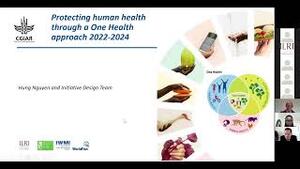
Quantifying weather and climate impacts on health in developing countries (QWeCI)
One of the most dramatic and immediate impacts of climate variation is that on disease, especially the vector-borne diseases that disproportionately affect the poorest people in Africa. Although we can clearly see that, for example, an El Nino event triggers Rift Valley Fever epidemics, we remain poor at understanding why particular areas are vulnerable and how this will change in coming decades, since climate change is likely to cause entirely new global disease distributions. This applies to most vector-borne diseases. At the same time, we do not know currently the limit of predictability of the specific climate drivers for vector-borne disease using state-of-the-art seasonal forecast models, and how to best use these to produce skilful infection-rate predictions on seasonal timescales. The QWeCI project thus aims to understand at a more fundamental level the climate drivers of the vector-borne diseases of malaria, Rift Valley Fever, and certain tick-borne diseases, which all have major human and livestock health and implications in Africa, in order to assist with their short-term management and make projections of their future likely impacts. QWeCI will develop and test the methods and technology required for an integrated decision support framework for health impacts of climate and weather. Uniquely, QWeCI will bring together the best in world integrated weather climate forecasting systems with health impacts modelling and climate change research groups in order to build an end-to-end seamless integration of climate and weather information for the quantification and prediction of climate and weather on health impacts in Africa.
Objectives/Goals
- Evaluate the use and awareness of predictions and projections of atmospheric variability on timescales of weeks (weather), months to seasons up to decades (climate) for quantification of health impacts in targeted countries
- Develop methods to tailor, for health impacts, output from weather and climate ensemble forecasts (days, seasons to decades) and scenario driven future climate projections from regional and global climate models
- Develop seamless approaches across the modelling streams that gives transparently produced climate and disease risk information for health impacts communities, to produce disease risk maps.
- Evaluate and implement user driven needs of post-processing of ensemble prediction and climate ensembles projection systems output to improve skill e.g. downscaling, and ensemble dressing.
- Diagnose and reassess climate-disease relationships for each targeted disease-location. This process will be done by means of diagnostic tools at the forefront of research, that assess the matching/coherency in behaviour of a model at a variety of space and time scales, and both for the frequency and time domain. The role of potential drivers of selected diseases will be individually assessed through cross-validation with sets of drivers and for different model configurations.
- Assess in the field the potential and effectiveness of new low-cost long-range two-way wireless (WiFi) technology to monitor disease incidence and epidemic outbreaks centrally, for both endemic response and forecast verification purposes.
- Define and/or refine climate-driven disease models after testing a suite of models of increasing complexity (including the University of Liverpool malaria model). The final configuration of the selected model for each targeted disease will be obtained after a strict model building process and its skill assessed through hindcast validation.
- Enhance the scope of the existing Liverpool National Centre for Zoonoses vector-pathogen-host database for climate related diseases impacting on human and animal health in Africa.
- Develop methods to quantify the use of climate and weather information, prediction and projection in evaluating the impacts of infectious diseases in Africa.
Expected outputs
- Climate health relations: disease database, atmospheric database, climate-disease associations
- Development of dynamic disease models
- Seamless atmospheric integrations: downscaled and calibrated seamless seasonal atmospheric forecasts, seamless decadal predictions and projections
- Coupled climate-health projections: seamless climate-disease model integrations
- Integrated decision support systems in three pilot projects: Ghana (Peri-urban malaria), Senegal (Rift Valley Fever and malaria), Malawi (disease risk dissemination by long range WiFi technology)
- Dissemination, training and assessment





















